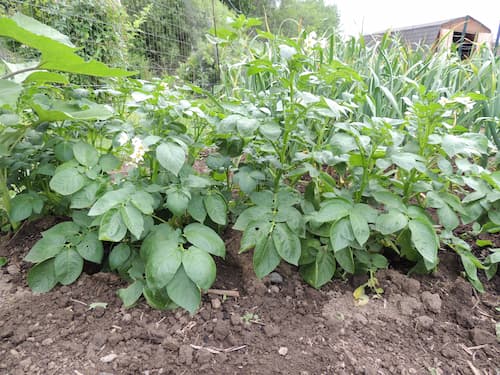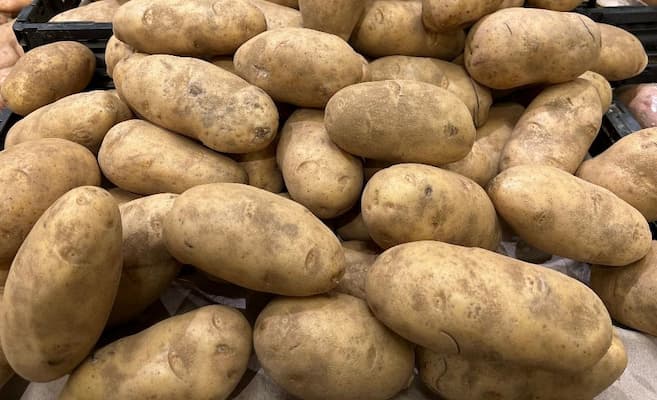How to Grow Potatoes

Growing Potato Plants in Your Home Garden
Ah!! The versatile and lovable potato. We use them in so many ways. Yet, it is not among the top pants grown in the vegetable garden. Growing these plants is not hard. However, there’s a fair amount of work to dig the hole and plant the seed potatoes. Then, you have to dig up the spuds to harvest the crop. To some, that’s just too much work. We don’t think the effort should deter you from growing homegrown potatoes. Go ahead, give it a try!
Spuds as they are affectionately nicknamed, are a regular at the dinner table, as well as breakfast and lunch. And let’s not forget all the snacks that are made from potatoes. Plain by itself, spuds do not have a strong, overpowering flavor. But the numerous ways we cook and serve it, and the wide variety of spices, herbs, and sauces added to or put on it, make for a tremendous number of delicious tastes.
Despite its mealtime appeal, it is surprising that more home gardeners do not grow them. Two or three hills do not take up an overly large amount of space. And, taters do not require a lot of maintenance. While you can buy, seed potatoes, the home gardener can use any potato that has been lying around the kitchen or pantry long enough to develop “eyes”.
Old Fashioned Headache Remedy: Put sliced, raw potatoes on your forehead. (Let us how if it works for you!)
Nicknames: Spuds, Taters, Tubers
Did You Know? Over 45 million pounds of potatoes are produced in the U.S. each year.
Botanical Name: Solanum Tuberosum
Varieties of Potatoes
Idaho – Famous for their quality as “Bakers”
White – This is the basic and most popular variety. It is used for everything from mashed to French fries.
Red, often called Russet Red – A less common variety with great taste!
Salt Potatoes – Don’t forget these. They are very small, smaller than a golf ball. They are popular at fall cookouts and clambakes.
Did you know? Potatoes were not part of the first Thanksgiving. They are native to South America. Spanish explorers discovered them in 1570, and brought them to Europe. Years later, when the Pilgrims landed at Plymouth Rock, they were not part of the cargo. Nor, had they yet made their way from South America to North America.
More Potato trivia: Potato chips were first made by Chef George Crum in Saratoga Springs, NY on August 24, 1853. Try our potato chip recipe.
Sowing Seed Potatoes
Potatoes are grown from “Seed Potatoes”. It is not a seed. Rather, it is a tuber that has developed one or more “eyes”. This eye is actually the spot where a root forms on the tuber. Each potato can have several “eyes”. Before planting, it can be cut into several pieces, each with at least one eye.
Did You Know? The plants actually produce seeds, too. If the plant is allowed to produce flowers, after the bloom dies off, a berry will form. The berry has seeds inside. These seeds are capable of producing new plants. But it takes much more time to grow than seed potatoes.
Most often gardeners buy seed potatoes from garden stores or online Etailers. It’s easier than making your own.
Garden Tip: You don’t have to make seed potatoes. Rather, you can use the whole tuber. Obviously, you will need more than if cut them up into several pieces with eyes. First, check your kitchen cupboard to find old taters that have sprouted eyes. Then, if you need more, ask around to friends and family.
Want to make your own seed potatoes? It’s a cinch! See: How to Make Seed Potatoes.
They can be planted as early as two weeks before the last frost in your area. They are susceptible to frost, but take a couple of weeks to root, and emerge from the soil.

How to Grow Potato Plants
Grow plants in full sun.
The plants grow best in soft “muck” soil. Wherever mucklands can be found, you will find onion or potato farming. The plants will grow in many other soils, too. But, root development is enhanced, by adding lots of compost and loose material into the soil. When preparing your soil, add compost, straw, and other amendments down three to six inches deep into your soil. See Compost Honey hole
While the plants like soft muckland, they do not like continuously wet soils. They will rot in these conditions.
Potatoes can be planted as early as two weeks before the last frost in your area. They are susceptible to frost but take a couple of weeks to root and emerge from the soil.
The most common form of planting is in “hills”. Prepare and loosen the soil where you will make the hill. Place two or three potato eyes on the ground. Cover or “hill” three to four inches of soil on top of the seed. Water thoroughly. Space center of hills a foot apart.
Growing Tip: Mix sulfur into the soil a week or two before planting. This will help avoid potato scab and rough skin.
A second and less common method is to use furrows. Dig a trench six to eight inches deep. Fill 1/2 the depth of the trench with a mixture of compost, mulch, straw, and garden soil. Sow the seed potato eyes in the trench every four to six inches. Cover three to four inches with loose garden soil and mulch.
Season Long Care for Potato Plants
Fertilize the plants every two to four weeks. Fertilizers high in nitrogen will result in a leafy, green plant at the expense of root development. A good fertilizer contains low levels of Nitrogen and high levels of phosphorus. 6-24-24, or 8-24-24, are good fertilizers.
Keep the soil moist, not wet. Water deeper as the season progresses to reach the deep roots. Allow the top of the soil to become slightly dry between waterings.
As the plants grow, mound additional soil around the plants every week or two. Do not let the tubers be exposed to sunlight. You can cover the soil around the plants with compost, mulch, or even black plastic.
Ideal Soil pH: 4.5- 6.0
Important: Potatoes exposed to sunlight turn green. Green potatoes produce a toxin that is poisonous to you. So, discard any that have green on it.
Also, see:
Soil Temperatures – Ideal germination temperature by vegetable
Staking and Caging Plants
Plants grow tall and will often fall over. Staking, caging, or fencing the plants, helps to keep them healthier, and to produce bigger spuds. It is important to do this early in the season. Install stakes or cages early in the season. Pushing stakes or cages into the ground later in the season will almost certainly go right through a few developing potatoes.
Insects and Pest Problems
The plants are susceptible to a number of pests. Among the most common are potato maggots.
A homemade recipe: Rhubarb juice seems to work well for potato bugs, just boil the rhubarb and let it cool. Then, pour it and around the plants.
Garden Insects – identify common garden insect pests and how to control them.
Potato Plant Diseases
The plants suffer from some of the same blight and mildew problems as tomatoes. Fungicides will help with fungus diseases. If the plant becomes too bushy, air circulation will be impaired and increase the chances of disease. Do not hesitate to thin a bushy plant to increase air circulation.
Plant Problems – Diagnosis, causes, and cures for many common plant disease problems.
Harvesting Potatoes
Several weeks after the plant has developed, very carefully, dig down among the roots to see if they have developed large enough tubers to harvest. Be careful not to sever the main taproot from the plant. Replace soil or mulch around the plant. Once they have become large enough for consumption, you can harvest as much as you need for your individual meals. After the plants have died off, dig out and around the entire plant. Be careful to dig our far enough that you do not slice into any potatoes while harvesting.
You need not hasten to dig out your potatoes after the plant has died. They will remain perfectly safe and healthy under your garden soil for weeks. Insects and pests, however, will continue to be a problem. You will have no respite from insects, moles or, mice munching upon the harvest.
Importantly, as mentioned previously, discard any that have any green color on the skin.
Did you know? Potatoes were not part of the first Thanksgiving. Irish immigrants had not yet brought them to North America.
Potato Plant Hardiness
Potatoes are quite susceptible to frost. While you can plant them in the ground before the last frost, make sure your timing is such that they do not sprout before the last frost date. Late season varieties are also susceptible to fall frost, even a mild one. While the plant will die back, the potato underneath the soil is safe from harm of frost or even freezes.
Did You Know? All parts of the plant except the tuber are toxic. Use gloves or wash your hands after handling this plant.
Potato Recipes
May we suggest:
Related Articles
People who liked this article will also like:
Please support our site. Shop for:
- rmmatthews100@hotmail.com
- 585-721-6528
- Rochester, NY
©1999-2024 GardenersNet.Com, All Rights Reserved

